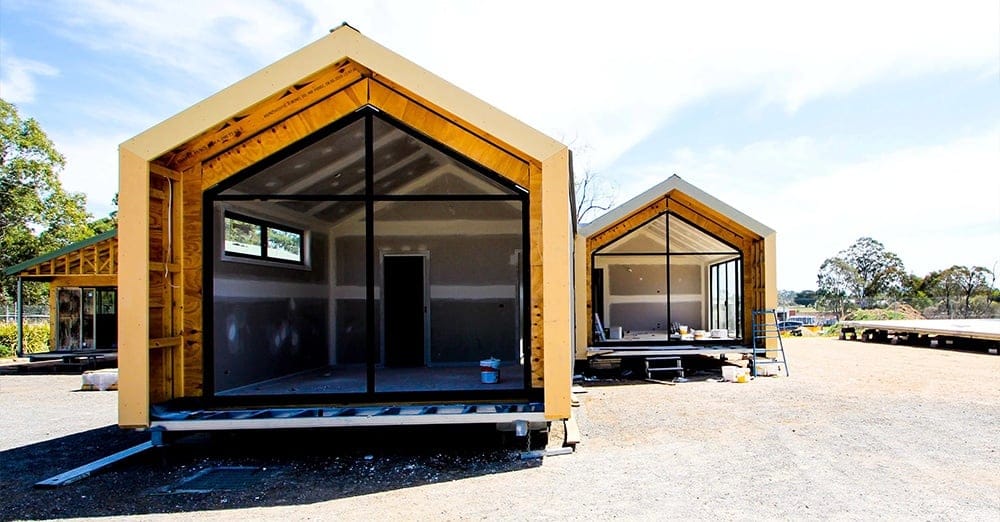Introduction
Back in 1974, Australia’s housing scene was feeling the squeeze—escalating costs, shortages, and a construction industry lagging behind modern expectations (sound familiar?).
So, a government task force rolled up its sleeves and dove headfirst into the big question: Could industrialised housing be the answer to the country’s housing woes?
This wasn’t just about using pre-fab panels or faster builds. It was a look into how to balance quality, cost, and performance while getting homes built quicker for people who needed them. But did they crack the code? Did their grand plans for efficiency and affordability hit the mark, or were they doomed by bureaucracy, consumer skepticism, and technical limitations?
In this blog, we’ll take a look at that 1974 Task Force report, break down its key ideas, and connect the dots to today’s housing challenges. Whether you’re a homeowner, builder, or just someone trying to make sense of why housing feels so complicated, this one’s for you.
Section 1: What Are Modern Housing Techniques?
In the 1974 report, “modern housing techniques” (the current term is MMC-Modern Methods Of Construction) referred to methods to streamline construction, reduce costs, and maintain (or improve) quality and amenity.
Think of it as a shift from old-school brick-by-brick building towards systems that could deliver homes faster and cheaper—without sacrificing livability.
The Task Force identified key preconditions for making this work:
- A Steady Market: Builders needed confidence that enough homes would be built each year to justify investing in new methods.
- Resource Efficiency: Smart use of materials and labour was essential to keep costs down.
- Top-Notch Management: From design to delivery, the process had to be well-managed and streamlined.
- National Standards: Consistent regulations across Australia would remove barriers caused by local council differences.
The idea was simple: make construction more like manufacturing, where standardisation, volume, and quality control lead to better, faster results.
However, these weren’t just technical challenges. The report hinted that changing how homes were built also meant overcoming entrenched habits in the industry—and in consumers' minds.
Section 2: Key Findings from the 1974 Task Force
So, what did the 1974 Task Force uncover? Quite a bit, actually. The main drivers for the research into modern housing techniques were clear:
-rising housing costs, shortages, and a construction sector that wasn’t exactly setting the world on fire with innovation.
Their key takeaways:
- Building Costs Were a Headache: Labour and materials were getting pricier, and traditional building methods weren’t helping.
- Land and Finance Added Pressure: Even if you cut building costs, expensive land and high-interest rates could still make homes unaffordable.
- Efficiency Was the Name of the Game: The report pushed for industrialisation—not just to save money, but to deliver homes faster and at consistent quality.
- Consumers Were a Hurdle: Many people were sceptical of factory-made or pre-fab homes, worried about design choices and durability.
- Integration of Skills Was Key: Construction wasn’t just about new materials or techniques—it was also about training and managing people effectively.
In essence, the report didn’t just call for change; it outlined the reasons why sticking with the same old methods would keep the housing crisis ticking along.
Section 3: Industrialised Techniques Explored
The Task Force didn’t just theorise; they looked at the nuts and bolts of how industrialised housing could work.
The report explored a variety of systems that aimed to move construction away from the traditional “one brick at a time” approach.
Here’s what they found:
- Framing Systems: These systems relied on pre-assembled frames—like steel or timber panels—that could be quickly put together on-site. It shaved off time and labour compared to traditional methods.
- Panellised Construction: Think of this as flat-pack houses. Wall and floor panels were made in a factory, transported to site, and assembled. This method promised better quality control and faster builds.
- Transportable and Mobile Homes: Entire homes (or major sections) were built in factories and delivered to site. While quick and cost-effective, these often faced pushback over design limitations and perceived lower status.
- Modular Systems: Like panellised systems but on steroids. Modular homes used fully finished sections—like bathrooms or entire rooms—that slotted together on-site. Fast, but with challenges in design flexibility and local acceptance.
Each system came with pros and cons:
✅ Faster construction, potentially lower costs, and improved quality control in factory settings.
❌ Design constraints, consumer reluctance, and tricky logistics in transporting and assembling large sections.
The report didn’t pick a clear winner but showed that each system could offer benefits if implemented thoughtfully.
Section 4: Overcoming Regulatory & Consumer Barriers
The report didn’t pull any punches when it came to the roadblocks. Even with shiny new construction techniques, success hinged on overcoming two big barriers: red tape and consumer skepticism.
Here’s what they identified:
- Regulatory Hurdles: Local councils were a patchwork of rules, each with its own requirements and standards. This inconsistency made it hard for industrialised methods to get traction, since something allowed in one area might be blocked in another.
- Consumer Conservatism: Homebuyers weren’t exactly lining up for factory-built homes. Many viewed them as inferior or “cheap,” fearing they lacked durability, design flexibility, or social status.
- Design Limitations: Many industrialised systems were seen as boxy and unappealing. Consumers wanted customisable, attractive homes, not cookie-cutter boxes.
- Market Fragmentation: Builders were often small-scale and focused on traditional methods, lacking the resources or incentive to shift towards new systems.
The Task Force’s solution? A national approach to building standards, combined with education and marketing to shift public perceptions.
They suggested:
- Improved Design: Make industrialised homes look as appealing as traditional ones.
- Clear Standards: National regulations to replace the local council maze.
- Consumer Education: Show buyers the benefits of these systems—quality, speed, cost savings.
In short, the path forward wasn’t just technical; it was about winning hearts and minds.
Section 5: Economic, Environmental, and Social Implications
The 1974 report didn’t stop at technical details—it also unpacked the broader implications of modern housing techniques on costs, the environment, and society.
Here’s what it found:
- Economic Realities: Sure, industrialised systems promised lower build costs. But land prices and financing terms were major contributors to overall housing costs. Even the cheapest build won’t be affordable if land and interest rates are sky-high. The report highlighted that a holistic approach was needed—one that combined affordable construction with smart land and finance strategies.
- Environmental Considerations: While environmental language wasn’t as prominent in the 1970s as it is today, the report touched on material choices and energy efficiency. It recognised the value of materials that reduced waste and suggested integrating solar energy and sustainable design features into housing developments.
- Social Impact: Modern housing techniques had the potential to improve access to affordable housing, particularly for lower-income families. But the report acknowledged a risk: if industrialised homes were perceived as “lesser,” it could reinforce social divides rather than bridge them.
The report’s unspoken warning was clear:
-without careful planning, these techniques could solve one problem (supply) while creating others (poor design, social stigma, environmental impact).
Section 6: Recommendations for Government and Industry
The Task Force didn’t just identify problems—it outlined practical steps to drive industrialised housing forward. Their recommendations were split between government actions and what the construction industry itself could do.
Government’s Role:
- National Standards: The report stressed the need for consistent, clear regulations across all states and councils. A national approach would remove the guesswork and delays that local approvals often caused.
- Prototype Support: Government-backed demonstration projects could showcase the benefits of industrialised systems and help shift public perception.
- Information Sharing: Establish research centres and technical information hubs to spread knowledge about new construction methods.
- Financial Assistance: Support for companies willing to invest in new techniques, especially in the early stages when costs are higher.
Industry’s Role:
- Better Design: Builders needed to focus on aesthetics and functionality, so industrialised homes wouldn’t just be fast and cheap—they’d be appealing too.
- Marketing & Education: The public needed to see the benefits clearly. This meant targeted marketing, show homes, and educational campaigns to build trust.
- Collaboration: Builders, manufacturers, and developers were urged to work together, sharing resources and expertise to make these systems work at scale.
Section 7: Lessons for Today’s Homeowners and Builders
So, what can we take away from a 1974 report about building homes? Turns out, quite a lot. Many of the same challenges—and opportunities—are still with us today.
Here’s what stands out:
- Cost vs. Quality Still Matters: The report highlighted that building faster and cheaper doesn’t mean sacrificing quality—if it’s done right. This is a lesson modern builders and homeowners can’t ignore, especially with rising material costs and skill shortages.
- Consumer Perceptions Count: Back then, buyers were wary of industrialised housing. Today, many people still hesitate about modular and prefabricated homes. Winning over consumers with better design, education, and transparency remains crucial.
- Regulations and Red Tape Are Ongoing Hurdles: In 1974, fragmented local regulations slowed progress. Today, while the National Construction Code (NCC) sets standards, local interpretations and planning laws can still be barriers to innovation.
- Collaboration Is Key: Just like the Task Force suggested, successful change requires teamwork. Builders, regulators, manufacturers, and homeowners all have a role in shifting towards more efficient, affordable, and sustainable housing.
- Innovation Needs Leadership: Whether it’s adopting new materials, construction methods, or sustainability standards, leadership from both industry and government is essential. Without it, we risk repeating the same issues highlighted in the report.
Comparing then to now shows that while some progress has been made—like improved codes and better building science—many challenges remain. The Task Force’s call for bold action still rings true.
Conclusion
The 1974 Task Force report wasn’t just a dusty document—it was a bold look at how Australia could tackle housing shortages, high costs, and inefficiencies. By exploring industrialised housing techniques, it laid out a roadmap for faster, smarter construction.
But even with its clear-eyed assessments and recommendations, many of the barriers it identified—regulations, consumer skepticism, market fragmentation—still linger today.
Fast forward to now, and we’re facing familiar challenges. Costs are climbing, demand is outpacing supply, and we’re still grappling with the need to build homes quickly without cutting corners.
The good news? The report’s lessons are still relevant. With modern tools, materials, and knowledge, we can pick up where it left off—if we’re willing to rethink old habits and embrace innovation.
So, whether you’re a homeowner dreaming of a first home, a builder navigating compliance headaches, or just curious about how Australia got here, the message is simple:
Learning from the past isn’t just useful—it’s essential
Frequently Asked Questions (FAQ's)
1. What are industrialised housing techniques?
Industrialised housing techniques involve using pre-made components, modular systems, and factory-built elements to construct homes faster and at potentially lower cost, while aiming to maintain or improve quality.
2. Why were these techniques promoted in the 1974 report?
The report highlighted the need to tackle rising housing costs, inefficiencies in traditional methods, and housing shortages. Industrialised techniques offered a path to faster, cheaper, and higher-quality construction.
3. How did consumers react to industrialised housing back then?
Many were skeptical. Concerns included design limitations, perceived lower quality, and worries that pre-fabricated homes would lack the status or individuality of traditional builds.
4. What were the key challenges identified by the Task Force?
The report pinpointed fragmented regulations, consumer skepticism, limited design flexibility, and a lack of industry-wide collaboration as major barriers.
5. How do today’s regulations support or hinder these approaches?
The National Construction Code (NCC) sets a national standard, but local councils can still interpret and apply rules differently. This can slow the adoption of innovative construction methods.
6. What role did government recommendations play?
The Task Force called for national standards, prototype support, information-sharing hubs, financial incentives, and collaboration across industry players to drive innovation.
7. Is the report still relevant to today’s housing issues?
Absolutely. Many of the challenges it identified—like costs, regulation, and consumer attitudes—are still present. Its recommendations remain a valuable guide for future action.
8. What can homeowners do to advocate for better housing?
Homeowners can educate themselves on modern construction options, ask builders about their methods, and support initiatives that promote innovation and affordability in housing.
9. What lessons can builders learn from this report?
Builders should focus on collaboration, education, and adopting new techniques that balance cost, quality, and speed—while also winning consumer trust.
10. Are there examples of these techniques in use today?
Yes! Modular and prefabricated homes are increasingly common, especially in regions facing housing shortages. However, widespread adoption is still limited by regulatory and perception challenges.
Further Reading












